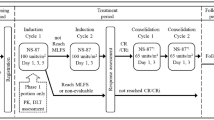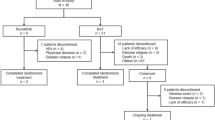Abstract
Sequential protocols combining salvage chemotherapy with reduced intensity conditioning (RIC) and allogeneic hematopoietic cell transplantation (alloHCT) for high-risk acute myeloid leukemia (AML) have been studied more than a decade. Purpose of this retrospective analysis was to evaluate the anti-leukemic efficacy and toxicity of FLAG-IDA protocol (fludarabine, cytarabine, and idarubicin) followed by treosulfan-based conditioning for patients with active AML. From January 2014 to November 2019, a total of 29 active AML patients [median age, 64 years (range, 23–73)] were treated. All patients completed protocol regimen and were transplanted. Five patients (17%) had grade 3–4 toxicities; therefore, treosulfan was substituted with total body irradiation (TBI) non-myeloablative conditioning. Six (20%) patients died within 30 post-transplant days, all from infectious complications. Out of 23 evaluable patients on day 30, 22 (96%) achieved complete hematologic remission with full donor chimerism. Non-relapse mortality (NRM) rates at 1 and 3 years were 22% and 49%, respectively. Median overall survival (OS) was 12 (95% CI, 4–20) months. OS and disease-free survival were 50% and 46% at 1 year and 28% and 17% at 2 years, respectively. Age, gender, disease burden, number of previous lines, and comorbidity score did not predict survival. Sequential strategy combining FLAG-IDA and treosulfan may offer a salvage option for few selected patients with active AML; however, high NRM presents a major obstacle to treatment success. Future efforts should focus on reducing NRM by moderating regimen intensity and by better selection of patients.

Similar content being viewed by others
References
Thol F, Schlenk RF, Heuser M, Ganser A (2015) How I treat refractory and early relapsed acute myeloid leukemia. Blood. 126(3):319–327
Zittoun RA, Mandelli F, Willemze R, de Witte T, Labar B, Resegotti L, Leoni F, Damasio E, Visani G, Papa G (1995) Autologous or allogeneic bone marrow transplantation compared with intensive chemotherapy in acute myelogenous leukemia. European Organization for Research and Treatment of Cancer (EORTC) and the Gruppo Italiano Malattie Ematologiche Maligne dell'Adulto (GIMEMA) Leukemia Cooperative Groups. N Engl J Med 332(4):217–223
Schmid C, Schleuning M, Ledderose G, Tischer J, Kolb HJ (2005) Sequential regimen of chemotherapy, reduced-intensity conditioning for allogeneic stem-cell transplantation, and prophylactic donor lymphocyte transfusion in high-risk acute myeloid leukemia and myelodysplastic syndrome. J Clin Oncol 23(24):5675–5687
Chemnitz JM, von Lilienfeld-Toal M, Holtick U, Theurich S, Shimabukuro-Vornhagen A, Krause A, Brossart P, Hallek M, Scheid C (2012) Intermediate intensity conditioning regimen containing FLAMSA, treosulfan, cyclophosphamide, and ATG for allogeneic stem cell transplantation in elderly patients with relapsed or high-risk acute myeloid leukemia. Ann Hematol 91(1):47–55
Dohner H, Estey E, Grimwade D, Amadori S, Appelbaum FR, Buchner T et al (2017) Diagnosis and management of AML in adults: 2017 ELN recommendations from an international expert panel. Blood. 129(4):424–447
Aoudjhane M, Labopin M, Gorin NC et al (2005) Acute comparative outcome of reduced intensity and myeloablative conditioning regimen in HLA identical sibling allogeneic haematopoietic stem cell transplantation for patients older than 50 years of age with acute myeloblastic leukaemia: a retrospective survey from the Acute Leukemia Working Party (ALWP) of the European Group for Blood and Marrow Transplantation (EBMT). Leukemia. 19:2304–2312
Pzepiorka D, Weisdorf D, Martin P et al (1995) Consensus conference on acute GVHD grading. Bone Marrow Transplant 15:825–828
Filipovich AH, Weisdorf D, Pavletic S, Socie G, Wingard JR, Lee SJ, Martin P, Chien J, Przepiorka D, Couriel D, Cowen EW, Dinndorf P, Farrell A, Hartzman R, Henslee-Downey J, Jacobsohn D, McDonald G, Mittleman B, Rizzo JD, Robinson M, Schubert M, Schultz K, Shulman H, Turner M, Vogelsang G, Flowers MED (2005) National Institutes of Health consensus development project on criteria for clinical trials in chronic graft-versus-host disease. I. Diagnosis and staging working group report. Biol Blood Marrow Transplant 11:945–956
Curigliano G, Cardinale D, Suter T et al (2012) Cardiovascular toxicity induced by chemotherapy, targeted agents and radiotherapy: ESMO Clinical Practice Guidelines. Ann Oncol 23(suppl 7):155–166
Krejci M, Doubek M, Dusek J, Brychtova Y, Racil Z, Navratil M, Tomiska M, Horky O, Pospisilova S, Mayer J (2013) Combination of fludarabine, amsacrine, and cytarabine followed by reduced-intensity conditioning and allogeneic hematopoietic stem cell transplantation in patients with high-risk acute myeloid leukemia. Ann Hematol 92(10):1397–1403
Schneidawind D, Federmann B, Faul C, Vogel W, Kanz L, Bethge WA (2013) Allogeneic hematopoietic cell transplantation with reduced-intensity conditioning following FLAMSA for primary refractory or relapsed acute myeloid leukemia. Ann Hematol 92(10):1389–1395
Holtick U, Herling M, Pflug N, Chakupurakal G, Leitzke S, Wolf D, Hallek M, Scheid C, Chemnitz JM (2017) Similar outcome after allogeneic stem cell transplantation with a modified FLAMSA conditioning protocol substituting 4 Gy TBI with treosulfan in an elderly population with high-risk AML. Ann Hematol 96(3):479–487
Decroocq J, Itzykson R, Vigouroux S, Michallet M, Yakoub-Agha I, Huynh A et al (2018) Similar outcome of allogeneic stem cell transplantation after myeloablative and sequential conditioning regimen in patients with refractory or relapsed acute myeloid leukemia: a study from the Societe Francophone de Greffe de Moelle et de Therapie Cellulaire. Am J Hematol 93(3):416–423
Watson AM, Seymour J, Lee N, Whiteside M, Firkin F (1994) An effective age-unrestricted m-AMSA-based secondline regimen for poor prognosis acute myeloid leukaemia. Eur J Haematol 52(2):80–86
Kessler T, Mohr M, Müller-Tidow C, Krug U, Brunnberg U, Mohr B, Schliemann C, Sauerland C, Serve H, Büchner T, Berdel WE, Mesters RM (2008) Amsacrine containing induction therapy in elderly AML patients: comparison to standard induction regimens in a matched-pair analysis. Leuk Res 32(3):491–494
Wang L, Devillier R, Wan M, Decroocq J, Tian L, Fürst S, Wang LN, Vey N, Fan X, Blaise D, Hu J (2019) Clinical outcome of FLAG-IDA chemotherapy sequential with Flu-Bu3 conditioning regimen in patients with refractory AML: a parallel study from Shanghai Institute of Hematology and Institut Paoli-Calmettes. Bone Marrow Transplant 54(3):458–464
Buchholz S, Dammann E, Stadler M, Krauter J, Beutel G, Trummer A, Eder M, Ganser A (2012) Cytoreductive treatment with clofarabine/ara-C combined with reduced-intensity conditioning and allogeneic stem cell transplantation in patients with high-risk, relapsed, or refractory acute myeloid leukemia and advanced myelodysplastic syndrome. Eur J Haematol 88(1):52–60
Ram R, Scheid C, Amit O, Chemnitz JM, Moshe Y, Hallek M et al. (2019) Sequential therapy for patients with primary refractory acute myeloid leukemia - historical prospective analysis of the German and Israeli experience. Haematologica
DiNardo CD, Pratz K, Pullarkat V et al (2019) Venetoclax combined with decitabine or azacitidine in treatment-naive, elderly patients with acute myeloid leukemia. Blood 133(1):7–17
Konopleva M, Pollyea DA, Potluri J, Chyla B, Hogdal L, Busman T, McKeegan E, Salem AH, Zhu M, Ricker JL, Blum W, DiNardo CD, Kadia T, Dunbar M, Kirby R, Falotico N, Leverson J, Humerickhouse R, Mabry M, Stone R, Kantarjian H, Letai A (2016) Efficacy and biological correlates of response in a phase II study of venetoclax monotherapy in patients with acute myelogenous leukemia. Cancer Discov 6(10):1106–1117
Bewersdorf JP, Giri S, Wang R, Williams RT, Tallman MS, Zeidan AM, Stahl M (2020) Venetoclax as monotherapy and in combination with hypomethylating agents or low dose cytarabine in relapsed and treatment refractory acute myeloid leukemia: a systematic review and meta-analysis. Haematologica haematol.2019.242826. https://doi.org/10.3324/haematol.2019.242826
DiNardo CD, Albitar M, Kadia T et al (2018) Venetoclax in combination with FLAG-IDA chemotherapy (FLAG-V-I) for fit, relapsed/refractory AML patients: interim results of a phase 1b/2 dose escalation and expansion study. Blood 132:4048
Pollyea DA, Amaya M, Strati P, Konopleva MY (2019) Venetoclax for AML: changing the treatment paradigm. Blood Adv 3(24):4326–4335
Ostronoff F, Ostronoff M, Souto-Maior AP et al (2009) Prospective trial of mycophenolate mofetil-cyclosporine A prophylaxis for acute GVHD after G-CSF stimulated allogeneic bone marrow transplantation with HLA-identical sibling donors in patients with severe aplastic anemia and hematological malignancies. Clin Transplant 23:33–38
Author information
Authors and Affiliations
Corresponding author
Ethics declarations
Conflict of interest
The authors declare that they have no conflict of interest.
Ethical approval
All procedures performed in studies involving human participants were in accordance with the ethical standards of the institutional and/or national research committee and with the 1964 Helsinki declaration and its later amendments or comparable ethical standards.
Informed consent
Informed consent was obtained from all individual participants included in the study.
Additional information
Publisher’s note
Springer Nature remains neutral with regard to jurisdictional claims in published maps and institutional affiliations.
Rights and permissions
About this article
Cite this article
Shargian-Alon, L., Wolach, O., Rozovski, U. et al. Sequential treatment with FLAG-IDA/treosulfan conditioning regimen for patients with active acute myeloid leukemia. Ann Hematol 99, 2939–2945 (2020). https://doi.org/10.1007/s00277-020-04232-x
Received:
Accepted:
Published:
Issue Date:
DOI: https://doi.org/10.1007/s00277-020-04232-x




